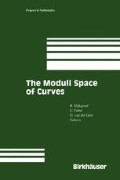Abstract
In this paper, we study two dg (differential graded) operads related to the homology of moduli spaces of pointed algebraic curves of genus 0. These two operads are dual to each other, in the sense of Kontsevich [21] and Ginzburg and Kapranov [14].
Access this chapter
Tax calculation will be finalised at checkout
Purchases are for personal use only
Preview
Unable to display preview. Download preview PDF.
References
V.I. Arnold, The cohomology ring of the colored braid group, Mat. Zametki 5 (1969), 227–231.
A. Beilinson, V. Ginzburg, Infinitesimal structure of moduli spaces of G-bundles, Internat. Math. Res. Notices (appendix to Duke Math. J.) 66 (1992), 63–74.
J.M. Boardman, R.M. Vogt, “Homotopy invariant algebraic structures on topological spaces,” Lecture Notes in Math. 347, 1973.
J.L. Brylinski, S. Zucker, An overview of recent advances in Hodge theory, in “Several complex variables, VI,” 39–142, Encyclopaedia Math. Sci. 69, Springer Verlag, Berlin, 1990.
F.R. Cohen, The homology of C n+1-spaces, n ≥ 0, in “The homology of iterated loop spaces,” Lecture Notes in Math. 533, 1976, 207–351.
P. Deligne, Théorie de Hodge II, Publ. Math. IHES 40 (1971), 5–58.
R. Dijkgraaf, E., H. Verlinde, Topological strings in d xxx I, Nucl. Phys. B352 (1991), 59–80.
W. Fulton, R. MacPherson, A compactification of configuration spaces, Ann. Math., 139 (1994), 183–225.
E. Getzler, Batalin-Vilkovisky algebras and two-dimensional topological field theories, Commun. Math. Phys. 159 (1994), 265–285.
E. Getzler, Equivariant cohomology and topological gravity, Commun. Math. Phys. 163 (1994), 473–490.
E. Getzler, J.D.S. Jones, Operads, homotopy algebra, and iterated integrals for double loop spaces, (hep-th/9403055).
E. Getzler, M. Kapranov, Cyclic operads and cyclic homology, to appear in “Geometry, Topology, and Physics for Raoul,” ed. S.T. Yau, International Press, Cambridge, MA, 1994.
E. Getzler, M. Kapranov, Modular operads, MPIM-Bonn preprint 94/78, (dg-ga/9408003).
V.A. Ginzburg, M.M. Kapranov, Koszul duality for operads, Duke. Math. J. 76 (1994), 203–272.
M. Gromov, Pseudo holomorphic curves in symplectic manifolds, Invent. Math. 82 (1985), 307–347.
A. Joyal, Foncteurs analytiques et especes de structures, Lecture Notes in Math. 1234 (1986) 126–159.
M.M. Kapranov, Permuto-associahedron, MacLane’s coherence theorem and asymptotic zones for the KZ equation, J. Pure Appl. Algebra, 85 (1993), 119–142
S. Keel, Intersection theory of moduli spaces of stable n-pointed curves of genus zero, Trans. Amer. Math. Soc. 330 (1992), 545–574.
A.A. Klyachko, Lie elements in the tensor algebra, Siberian Math. J., 15 (1974), 914–920.
F.F. Knudsen, The projectivity of the moduli space of stable curves II. The stacks M g, n, Math. Scand. 52 (1983), 161–189.
M. Kontsevich, Formal (non)-commutative symplectic geometry, in “The Gelfand mathematics seminars, 1990–1992,” eds. L. Corwin, I. Gelfand, J. Lepowsky, Birkhäuser, Boston, 1993.
M. Kontsevich, Yu. Manin, Gromov-Witten classes, quantum cohomology, and enumerative geometry, Commun. Math. Phys. 164 (1994), 525–562.
I.G. Macdonald, “Symmetric Functions and Hall Polynomials,” Clarendon Press, Oxford, 1979.
D. McDuff, D. Salamon, “J-holomorphic curves and quantum cohomology,”Amer. Math. Soc., Providence, 1994.
S. Mac Lane, “Categories for the working mathematician,” Graduate Texts in Math. 5, 1971.
M. Markl, Models for operads, preprint, 1994.
D. Quillen, Rational homotopy theory, Ann. Math. 90 (1969), 205–295.
Y. Ruan, G. Tian, A mathematical theory of quantum cohomology, Math. Res. Lett. (1994), 269–278.
Author information
Authors and Affiliations
Editor information
Editors and Affiliations
Rights and permissions
Copyright information
© 1995 Birkhäuser Boston
About this paper
Cite this paper
Getzler, E. (1995). Operads and Moduli Spaces of Genus 0 Riemann Surfaces. In: Dijkgraaf, R.H., Faber, C.F., van der Geer, G.B.M. (eds) The Moduli Space of Curves. Progress in Mathematics, vol 129. Birkhäuser Boston. https://doi.org/10.1007/978-1-4612-4264-2_8
Download citation
DOI: https://doi.org/10.1007/978-1-4612-4264-2_8
Publisher Name: Birkhäuser Boston
Print ISBN: 978-1-4612-8714-8
Online ISBN: 978-1-4612-4264-2
eBook Packages: Springer Book Archive

